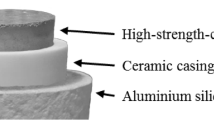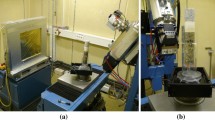Abstract
This paper investigates the feasibility of imaging the movement of water into partially saturated concrete using electrical resistance tomography (ERT). With this technique, the spatial distribution of electrical resistance within the concrete sample was acquired from 4-point electrical measurements obtained on its surface. As the ingress of water influences the electrical properties of the concrete, it is shown that ERT can assist in monitoring and visualising water movement within concrete. To this end, the difference-imaging technique was used to obtain a qualitative representation of moisture distribution within concrete during the initial 20-h absorption. It is shown that the technique also enables the influence of surface damage to be studied.







Similar content being viewed by others
References
McCarter, W.J., Ezirim, H., Emerson, M.: Properties of concrete in the cover zone: water penetration, sorptivity and ionic ingress. Mag. Concr. Res. 48(176), 149–156 (1996)
McCarter, W.J., Chrisp, T.M., Butler, A., Basheer, P.A.M.: Near–surface sensors for condition monitoring of cover-zone concrete. Constr. Build. Mater. 15(2–3), 115–124 (2001)
Thomas, M.D., Bamforth, P.B.: Modelling chloride diffusion in concrete: effect of fly ash and slag. Cem. Concr. Res. 29(4), 487–495 (1999)
Ishida, T., Iqbal, P.O., Anh, H.T.: Modeling of chloride diffusivity coupled with non-linear binding capacity in sound and cracked concrete. Cem. Concr. Res. 39(10), 913–923 (2009)
Kim, J., McCarter, W.J., Suryanto, B., Nanukuttan, S.V., Basheer, P.A.M., Chrisp, T.M.: Chloride ingress into marine exposed concrete: a comparison of empirical-and physically-based models. Cem. Concr. Compos. 72, 133–145 (2016)
Weiss, W.J., Yang, W., Shah, S.P.: Shrinkage cracking of restrained concrete slabs. ASCE J. Eng. Mech. 124(7), 765–774 (1998)
Mihashi, H., de Leite, J.P.: State-of-the-art report on control of cracking in early age concrete. J. Adv. Concr. Technol. 2(2), 141–154 (2004)
Beaudoin, J.J., MacInnis, C.: The mechanism of frost damage in hardened cement paste. Cem. Concr. Res. 4(2), 139–147 (1974)
Bleszynski, R., Hooton, R.D., Thomas, M.D., Rogers, C.A.: Durability of ternary blend concrete with silica fume and blast-furnace slag: laboratory and outdoor exposure site studies. ACI Mater. J. 99(5), 499–508 (2002)
Takahashi, Y., Ogawa, S., Tanaka, Y., Maekawa, K.: Scale-dependent ASR expansion of concrete and its prediction coupled with silica gel generation and migration. J. Adv. Concr. Technol. 14(8), 444–463 (2016)
Fujiyama, C., Tang, X.J., Maekawa, K., An, X.H.: Pseudo-cracking approach to fatigue life assessment of RC bridge decks in service. J. Adv. Concr. Technol. 11(1), 7–21 (2013)
Suryanto, B., Nagai, K., Maekawa, K.: Bidirectional multiple cracking tests on high-performance fiber-reinforced cementitious composite plates. ACI Mater. J. 107(5), 450–460 (2010)
Beushausen, H., Alexander, M.G., Andrade, C., Basheer, M., Baroghel-Bouny, V., Corbett, D., d’Andréa, R., Gonçalves, A., Gulikers, J., Jacobs, F., Monteiro, A.V., Nanukuttan, S.V., Otieno, M., Polder, R., Torrent, R.: Application examples of performance-based specification and quality control. In: Beushausen, H., Luco, L.F. (eds.) Performance-based Specifications and Control of Concrete Durability: State-of-the-Art Report RILEM TC 230-PSC, pp. 197–266. Springer, Dordrecht (2016)
Karhunen, K., Seppänen, A., Lehikoinen, A., Monteiro, P.J.M., Kaipio, J.P.: Electrical resistance tomography imaging of concrete. Cem. Concr. Res. 40, 137–145 (2010)
Zhang, T., Zhou, L., Ammari, H., Seo, J.K.: Electrical impedance spectroscopy-based defect sensing technique in estimating cracks. Sensors 15(5), 10909–10922 (2015)
Hallaji, M., Seppänen, A., Pour-Ghaz, M.: Electrical resistance tomography to monitor unsaturated moisture flow in cementitious materials. Cem. Concr. Res. 69, 10–18 (2015)
Smyl, D., Rashetnia, R., Seppänen, A., Pour-Ghaz, M.: Can electrical resistance tomography be used for imaging unsaturated moisture flow in cement-based materials with discrete cracks? Cem. Concr. Res. 91, 61–72 (2017)
Hou, T.C., Lynch, J.P.: Electrical impedance tomographic methods for sensing strain fields and crack damage in cementitious structures. J. Intell. Mater. Syst. Struct. 20(11), 1363–1379 (2009)
Hallaji, M., Pour-Ghaz, M.: A new sensing skin for qualitative damage detection in concrete elements: rapid difference imaging with electrical resistance tomography. NDT&E Int. 68, 13–21 (2014)
Hallaji, M., Seppänen, A., Pour-Ghaz, M.: Electrical impedance tomography-based sensing skin for quantitative imaging of damage in concrete. Smart Mater. Struct. 23, 085001 (2014)
Asgharzadeh, A., Reichling, K., Raupach, M.: Electrical impedance tomography on concrete, vol. 19. The International Symposium on Non-Destructive Testing in Civil Engineering (NDT-CE), Berlin, Germany (2015)
McCarter, W.J., Emerson, M., Ezirim, H.: Properties of concrete in the cover zone: developments in monitoring techniques. Mag. Concr. Res. 47(172), 243–251 (1995)
McCarter, W.J., Chrisp, T.M., Starrs, G., Adamson, A., Owens, E., Basheer, P.A.M., Nanukuttan, S.V., Srinivasan, S., Holmes, N.: Developments in performance monitoring of concrete exposed to extreme environments. ASCE J. Infrastruct. Syst. 18, 167–175 (2012)
McCarter, W.J., Chrisp, T.M., Starrs, G., Adamson, A., Basheer, P.A.M., Nanukuttan, S.V., Srinivasan, S., Green, C.: Characterization of physio-chemical processes and hydration kinetics in concretes containing supplementary cementitious materials using electrical property measurements. Cem. Concr. Res. 50, 26–33 (2013)
Polydorides, N., Lionheart, W.R.: A Matlab toolkit for three-dimensional electrical impedance tomography: a contribution to the Electrical Impedance and Diffuse Optical Reconstruction Software project. Meas. Sci. Technol. 13(12), 1871–1883 (2002)
Cheng, K.S., Isaacson, D., Newell, J.C., Gisser, D.G.: Electrode models for electric current computed tomography. IEEE Trans. Biomed. Eng. 36(9), 918–924 (1989)
Adler, A., Guardo, R.: Electrical impedance tomography: regularized imaging and contrast detection. IEEE Trans. Med. Imaging 15(2), 170–179 (1996)
Brown, B.H., Seagar, A.D.: The Sheffield data collection system. Clin. Phys. Physiol. Meas. 8(A), 91–97 (1987)
BS EN 197-1:2011: Cement: Composition, Specifications and Conformity Criteria for Common Cements. British Standards Institution, London (2000)
EIDORS: Electrical Impedance Tomography and Diffuse Optical Tomography Reconstruction Software. http://eidors3d.sourceforge.net/. Accessed 10 July 2016
Adler, A., Lionheart, W.R.B.: Uses and abuses of EIDORS: an extensible software base for EIT. Physiol. Meas. 27(5), S25–S42 (2006)
Adler, A., Arnold, J.H., Bayford, R., Borsic, A., Brown, B., Dixon, P., Faes, T.J., Frerichs, I., Gagnon, H., Gärber, Y., Grychtol, B.: GREIT: a unified approach to 2D linear EIT reconstruction of lung images. Physiol. Meas. 30(6), S35–S55 (2009)
Kauppinen, P., Hyttinen, J., Malmivuo, J.: Sensitivity distribution visualizations of impedance tomography measurement strategies. Int. J. Bioelectromagn. 8(1), 1–9 (2006)
Adler, A., Gaggero, P.O., Maimaitijiang, Y.: Adjacent stimulation and measurement patterns considered harmful. Physiol. Meas. 32(7), 731–744 (2011)
McCarter, W.J., Chrisp, T.M., Starrs, G., Holmes, N., Basheer, L., Basheer, P.A.M., Nanukuttan, S.V.: Developments in monitoring techniques for durability assessment of cover-zone concrete. In: 2nd International Conference on Durability of Concrete and Structures, Sapporo, Japan (2010)
McCarter, W.J., Chrisp, T.M., Starrs, G., Basheer, P.A.M., Blewett, J.: Field monitoring of electrical conductivity of cover-zone concrete. Cem. Concr. Compos. 27(7), 809–817 (2005)
Acknowledgements
The authors wish to acknowledge financial support from the School of Energy, Geoscience, Infrastructure and Environment at Heriot-Watt University. Two of the Authors (DS and HMT) also wish to acknowledge the financial support provided by Heriot-Watt University.
Author information
Authors and Affiliations
Corresponding author
Rights and permissions
About this article
Cite this article
Suryanto, B., Saraireh, D., Kim, J. et al. Imaging water ingress into concrete using electrical resistance tomography. Int J Adv Eng Sci Appl Math 9, 109–118 (2017). https://doi.org/10.1007/s12572-017-0190-9
Published:
Issue Date:
DOI: https://doi.org/10.1007/s12572-017-0190-9




